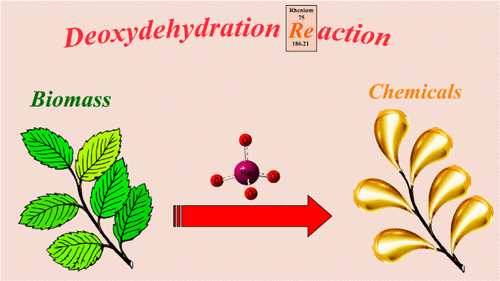当前位置:
X-MOL 学术
›
J. Phys. Chem. A
›
论文详情
Our official English website, www.x-mol.net, welcomes your
feedback! (Note: you will need to create a separate account there.)
Perrhenate-Catalyzed Deoxydehydration of a Vicinal Diol: A Comparative Density Functional Theory Study
The Journal of Physical Chemistry A ( IF 2.7 ) Pub Date : 2017-11-08 00:00:00 , DOI: 10.1021/acs.jpca.7b08884 Jamaladin Shakeri 1, 2 , Hassan Hadadzadeh 1 , Hossein Farrokhpour 1 , Mohammad Joshaghani 2 , Matthias Weil 3
The Journal of Physical Chemistry A ( IF 2.7 ) Pub Date : 2017-11-08 00:00:00 , DOI: 10.1021/acs.jpca.7b08884 Jamaladin Shakeri 1, 2 , Hassan Hadadzadeh 1 , Hossein Farrokhpour 1 , Mohammad Joshaghani 2 , Matthias Weil 3
Affiliation

|
Oxo–rhenium compounds, such as perrhenate salts, have demonstrated preferable activity in catalyzing the deoxydehydration (DODH) reaction in the presence of reductants. Here, the first computational details of the reported DODH mechanisms are presented using the density functional theory (DFT) (M06/6-311+G(d,p)/LANL2DZ) to investigate the conversion of a vicinal diol into the corresponding alkene by ReO4– as a catalyst. The DFT studies were carried out to evaluate the DODH mechanisms, from the energy point of view, for the conversion of phenyl-1,2-ethanediol to styrene by perrhenate anion in the presence of PPh3 as a reductant through a detailed comparison of two potential pathways including pathway A and pathway B. Pathway A includes the sequence of condensation of oxo–Re(VII) with diol before the reduction of Re(VII) to Re(V), whereas pathway B involves the reduction of oxo–Re(VII) to oxo–Re(V) before the condensation process. In pathway B, two basic routes (B1 and B2) are possible, which can take place through different reaction steps, including the extrusion of alkene from Re(V)–diolate in route B1, and the second reduction of the Re(V)–diolate by reductant and then the extrusion of alkene from the Re(III)–diolate intermediate in route B2. The intermediates and the Gibbs free energy changes, including ΔG°g and ΔG°sol, have been calculated for alternative pathways (A and B) in the gas and solvent (chlorobenzene and methanol) phases and compared to each other. In addition, the transition states and the activation energy barriers for two pathways (A and B) in the gas phase and in chlorobenzene have been calculated. The key transition states include the nucleophilic attack of PPh3 on an Re═O bond, the dissociation of OPPh3 from the rhenium moiety, the transfer of an H atom of diol to the oxo ligand in an oxo—Re bond through the condensation step, and the extrusion of styrene from the Re–diolate complexes. The DFT results indicate that the DODH reaction is thermodynamically feasible through both pathways (A and B). However, the calculations reveal that the perrhenate-catalyzed DODH reaction through pathway A has the lowest overall activation barrier energy among the DODH mechanism routes.
中文翻译:

高r酸酯催化的邻苯二甲酸二元酯的脱水作用:比较密度泛函理论研究
氧化–化合物,例如高hen酸盐,在还原剂的存在下表现出较好的催化脱氧脱水(DODH)反应的活性。在这里,使用密度泛函理论(DFT)(M06 / 6-311 + G(d,p)/ LANL2DZ)展示了所报道的DODH机理的第一个计算细节,以研究邻位二醇通过以下方法转化为相应的烯烃ReO 4 –作为催化剂。从能量的观点出发,进行了DFT研究以评估DODH机理,以探讨在PPh 3存在下高r酸酯阴离子将1,2,2-乙二醇转化为苯乙烯的过程。通过详细比较两个潜在途径(包括途径A和途径B)作为还原剂。途径A包括OXo-Re(VII)与二醇缩合的序列,然后将Re(VII)还原为Re(V),而途径B涉及在缩合过程之前将oxo-Re(VII)还原为oxo-Re(V)。在途径B中,两条基本路线(B1和B2)是可能的,可以通过不同的反应步骤进行,包括在路线B1中从Re(V)-二醇盐中挤出烯烃,以及第二次还原Re(V)还原剂生成–二醇盐,然后从路线B2的Re(III)–二醇盐中间体中挤出烯烃。中间体和吉布斯自由能的变化,包括ΔG ° g和ΔG ° sol已计算出气相和溶剂(氯苯和甲醇)相中的替代途径(A和B),并进行了比较。此外,还计算了气相和氯苯中两个路径(A和B)的过渡态和活化能垒。关键的过渡态包括PPh 3对Re═O键的亲核攻击,OPPh 3的解离从the部分开始,二醇的H原子通过缩合步骤转移到ox-Re键的oxo-Re配体上,然后从Re-diolate络合物中挤出苯乙烯。DFT结果表明,DODH反应通过两种途径(A和B)在热力学上都是可行的。然而,计算表明,在DODH机理途径中,通过途径A的高r酸盐催化的DODH反应具有最低的总活化势垒能。
更新日期:2017-11-08
中文翻译:

高r酸酯催化的邻苯二甲酸二元酯的脱水作用:比较密度泛函理论研究
氧化–化合物,例如高hen酸盐,在还原剂的存在下表现出较好的催化脱氧脱水(DODH)反应的活性。在这里,使用密度泛函理论(DFT)(M06 / 6-311 + G(d,p)/ LANL2DZ)展示了所报道的DODH机理的第一个计算细节,以研究邻位二醇通过以下方法转化为相应的烯烃ReO 4 –作为催化剂。从能量的观点出发,进行了DFT研究以评估DODH机理,以探讨在PPh 3存在下高r酸酯阴离子将1,2,2-乙二醇转化为苯乙烯的过程。通过详细比较两个潜在途径(包括途径A和途径B)作为还原剂。途径A包括OXo-Re(VII)与二醇缩合的序列,然后将Re(VII)还原为Re(V),而途径B涉及在缩合过程之前将oxo-Re(VII)还原为oxo-Re(V)。在途径B中,两条基本路线(B1和B2)是可能的,可以通过不同的反应步骤进行,包括在路线B1中从Re(V)-二醇盐中挤出烯烃,以及第二次还原Re(V)还原剂生成–二醇盐,然后从路线B2的Re(III)–二醇盐中间体中挤出烯烃。中间体和吉布斯自由能的变化,包括ΔG ° g和ΔG ° sol已计算出气相和溶剂(氯苯和甲醇)相中的替代途径(A和B),并进行了比较。此外,还计算了气相和氯苯中两个路径(A和B)的过渡态和活化能垒。关键的过渡态包括PPh 3对Re═O键的亲核攻击,OPPh 3的解离从the部分开始,二醇的H原子通过缩合步骤转移到ox-Re键的oxo-Re配体上,然后从Re-diolate络合物中挤出苯乙烯。DFT结果表明,DODH反应通过两种途径(A和B)在热力学上都是可行的。然而,计算表明,在DODH机理途径中,通过途径A的高r酸盐催化的DODH反应具有最低的总活化势垒能。










































 京公网安备 11010802027423号
京公网安备 11010802027423号